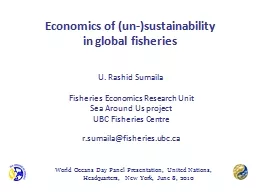

in global fisheries U Rashid Sumaila Fisheries Economics Research Unit Sea Around Us project UBC Fisheries Centre rsumailafisheriesubcca World Oceans Day Panel Presentation United Nations Headquarters New York June 8 2010 ID: 301997
Download Presentation The PPT/PDF document "Economics of (un-)sustainability" is the property of its rightful owner. Permission is granted to download and print the materials on this web site for personal, non-commercial use only, and to display it on your personal computer provided you do not modify the materials and that you retain all copyright notices contained in the materials. By downloading content from our website, you accept the terms of this agreement.
Slide1
Economics of (un-)sustainability in global fisheries
U. Rashid SumailaFisheries Economics Research UnitSea Around Us projectUBC Fisheries Centrer.sumaila@fisheries.ubc.ca
World Oceans Day Panel Presentation, United Nations, Headquarters, New York, June 8, 2010 Slide2
Outline of talkWhy are ocean fisheries considered to be un-sustainable?
Why should we strive for sustainability in ocean fisheries?What are the elements of sustainability in ocean fisheries?Slide3
Overview of sustainabilitySlide4
Origins of sustainabilityMany would trace the origins of sustainability to the Brundtland Report: WCED (1987):development that "meets the needs of the present generation without compromising the ability of future generations to meet their own needs”.But there is a longer history …Slide5
Photo: NASA
“The Earth and the fullness of it belongs to every generation, and the preceding one can have no right to blind it up from posterity” (Adam Smith, 1766 Lecture on Jurisprudence).Slide6
The sustainable development challengeHow to reconcile society’s development goals with the planet’s environmental limits over the long term:Fish protein;Jobs and income;
Profits.Slide7
Ocean fish sustainabilitySustainability focuses on the dynamic interactions between nature and society – in our case, the interaction between fish & fishers:Example: how vulnerable are different parts of the ocean? Slide8
Intrinsic growth rate as indicator of vulnerability
Sumaila, Cheung et al. (in prep.) Slide9
Official discount rates as indicator of vulnerability
Sumaila, Cheung et al. (in prep.) Slide10
Conservation indices for all fish species, globally
Includes all fish species (assumed private discount rate).Slide11
Ocean fish sustainabilitySustainability pays attention to how social and economic change shape
the environment and how the environmental change shapes society;Example: fisheries subsidies: payments by governments to fishing sector.Slide12
Sumaila et al. (2010) Slide13
Ocean fish sustainabilitySustainability is problem-driven, with the goal of creating and applying knowledge in support of decision-making for sustainable development;Example illegal fishing.Slide14
Number of incriminated vessels fishing illegally between 1980 and 2003
Sumaila et al. (2006) Slide15
Costs and benefit aspects of risks inherent in IUU activity
Arresting Country
Fishery
Expected Revenue (USD)
Expected Penalty (USD)
Total Cost (USD)
Total Cost / Expected revenue
Australia
Patagonian toothfish
504 000
87 000
526 091
1.04
Japan
Crab
38 256
1 483
31 131
0.81
Mexico
Shrimp
22 060
1 091
16 428
0.74
Russia
Alaska pollack
8 818
234
4 539
0.51
Mauritius
Patagonian toothfish
352 000
480 000
786 667
2.23
Sumaila et al.
(2006
) Slide16
Ocean fish sustainabilitySustainability is grounded in the belief that for the knowledge of nature-society interaction to be truly useful, they have to be ‘co-produced’ through close collaboration between scholars, managers, fishers, industry, and policy makers at different scales:Example this meeting.
NRC (1999); Clark and Dickson (2003)Slide17
The need to strive for sustainabilitySlide18
Ocean fisheries activities
Ocean fish populations
Aquaculture
Capture
fisheries
Seafood
processing
Management cost
Recreational
fisheries
&
tourism
Marine
manufacturing
&
services
, boat building
Marine
research
Fishing ports and jettiesSlide19
Input – output resultsFisheries are a primary or ‘base’ industrySource of resources out of which much economic activity grows.How much economic activity throughout the economy is sourced from fisheries output?
Dyck & Sumaila (2010) Slide20
Economic impact of world fisheries output
Landed Value ($ billions)Economic Impact ($ billions)
Average MultiplierAfrica
2
5
2.59
Asia
50
133
2.67
Europe
11
36
3.12
S. & C. America
7
15
2.05
N. America
8
29
3.52
Oceania
5
17
3.27
World Total
84
235
2.8
Dyck & Sumaila (2010
) Slide21
Income effect of world fisheries output
Landed Value ($ billions)Income Effect ($ billions)Average Multiplier
Africa2
1
0.62
Asia
50
35
0.71
Europe
11
9
0.76
S. & C. America
7
4
0.56
N. America
8
10
1.22
Oceania
5
4
0.73
World Total
84
63
0.75
Dyck & Sumaila (2010) Slide22
Catch data: individual fisheriesSlide23
Global Potential Catch Loss (in million tonnes
)Srinivasan et al. (2010) Slide24
Food security implications of overfishingOur analysis shows that eliminating overfishing could create food to avert undernourishment for about 20 million people mostly in countries with very high levels of undernourishment in their populations (e.g., Liberia, Sri Lanka, Grenada, Guatemala).
Srinivasan et al. (2010) Slide25
Elements of sustainabilitySlide26
Elements of sustainability in fisheriesRecognize that there are limits to the amount of fish that the ocean can provide;Acknowledge that rebuilding overfished stocks is needed so they can deliver maximum sustainable yield through time for the benefits of all generations;Slide27
Elements of sustainability in fisheriesEssential fish habitats need to be protected and preserved;Fishing and related activities are carried out to minimize the release of greenhouse gases;Education, education, education. Slide28
Elements of sustainability in fisheriesGlobal governance: sustainability based on the ecosystem approach such as the use of marine protected area;Subsidies disciplines;Joint management of
shared stocks, e.g., high seas fish stocks;Make it economically costly to engage in IUU fishing;Encourage co-management of fisheries;Define access rights to communities, etc. Slide29
Thanks for your attention